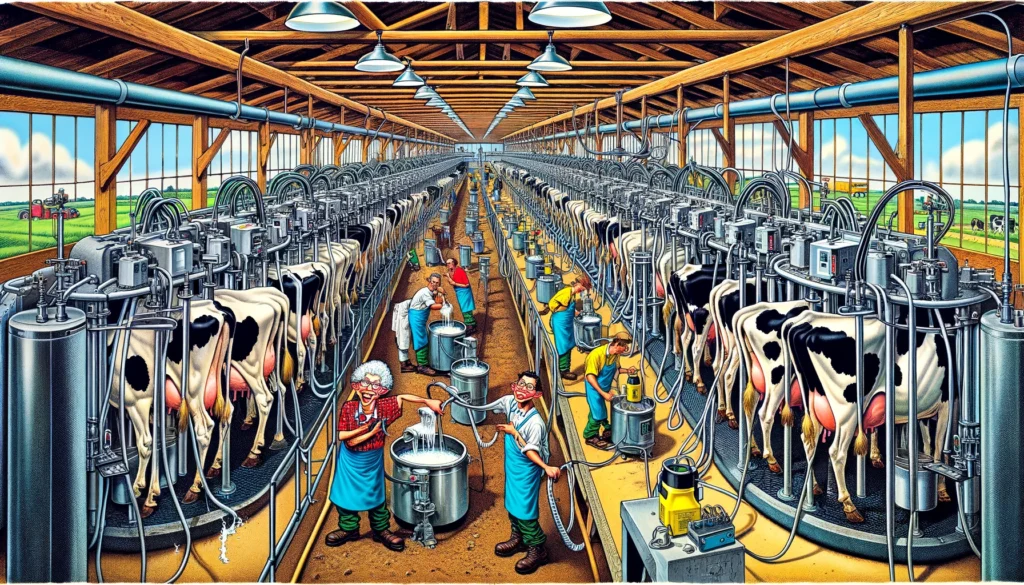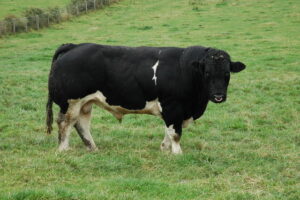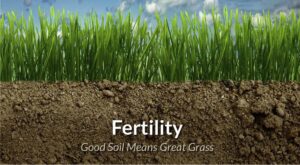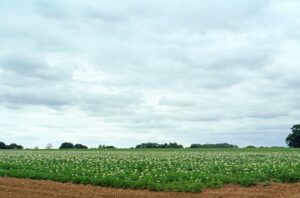
Dairy Farm A detailed and vivid illustration in the exaggerated satirical style of Mad Magazine depicting the interior of a milking barn on a dairy farm. The s 2.webp.webp
Dairy Farm
Definition:
A dairy farm is an agricultural enterprise where cows, goats, sheep, or other lactating animals are raised and managed for the production of milk, dairy products, or milk-derived commodities for human consumption. Dairy farming involves the husbandry, breeding, feeding, milking, and management of dairy animals in specialized facilities or systems designed to optimize milk production, quality, and efficiency in milk processing and marketing.
Description:
Dairy farms are integral components of the dairy industry, supplying fluid milk, cheese, butter, yogurt, ice cream, and other dairy products to consumer markets, food processors, and foodservice establishments worldwide. Dairy farming practices vary in scale, scope, and management intensity, ranging from small-scale family farms and traditional dairies to large-scale commercial operations and modernized production facilities equipped with automated milking systems, herd management software, and precision agriculture technologies.
Fall off the barn roof and busted your keister? Life on the farm or ranch can be tough on the bum. Need a break? Laugh it off at FarmerCowboy.com, the #1 farm humor site. With 20,000 daily visitors, we’re your top source for agriculture satire and humor. Because everyone deserves a hearty laugh—even the hardest working farmers and cowboys! Join us and turn those long days into fun tales at FarmerCowboy.com.
Components of a Dairy Farm:
Key components of a dairy farm include:
- Herd Management: Dairy farms maintain herds of dairy animals, such as cows, goats, or sheep, managed for milk production, reproduction, health, and welfare, utilizing breeding programs, genetic selection, artificial insemination, or reproductive technologies to optimize herd genetics, productivity, and profitability.
- Milking Facilities: Dairy farms feature milking parlors, milking stanchions, or milking robots for extracting milk from lactating animals, employing manual, semi-automatic, or fully automated milking systems to harvest milk efficiently, hygienically, and safely while minimizing labor requirements and milking stress for dairy cows.
- Feed Management: Dairy farms provide balanced diets, nutritionally formulated rations, or total mixed diets (TMRs) composed of forages, grains, concentrates, protein supplements, and minerals to meet the energy, protein, vitamin, and mineral requirements of dairy animals, promoting milk yield, composition, and quality in lactating cows.
- Housing and Facilities: Dairy farms house dairy animals in freestall barns, tie-stall barns, pasture-based systems, or open-lot facilities designed to accommodate different herd sizes, management systems, and climatic conditions, providing shelter, comfort, ventilation, and access to feed, water, and resting areas for dairy cattle.
- Manure Management: Dairy farms manage manure, waste, or effluent generated from dairy operations through storage, treatment, or utilization practices to minimize environmental impacts, nutrient runoff, or odor emissions associated with dairy waste, promoting nutrient recycling, soil fertility, and environmental stewardship on dairy farms.
Dairy Farming Operations:
Dairy farming operations involve several stages, including:
- Calving: Dairy cows give birth to calves, initiating lactation and milk production, typically following a gestation period of 9 months, calving events are managed to coincide with peak milk production, lactation curves, or seasonal breeding patterns in dairy herds.
- Milking: Dairy cows are milked 2-3 times daily using milking machines, automated milking systems, or manual milking techniques, extracting milk from udders, storing milk in bulk tanks, or transporting milk to on-farm milk cooling and storage facilities for immediate refrigeration and preservation.
- Feeding: Dairy cows receive balanced diets, including roughages, grains, silages, and concentrates, tailored to their nutritional needs, production stage, lactation cycle, or metabolic requirements, ensuring optimal milk yield, milk composition, and cow health in dairy farming systems.
- Healthcare: Dairy cows undergo routine health monitoring, disease prevention, and veterinary care procedures, including vaccinations, deworming, foot trimming, and reproductive management, to maintain cow health, prevent diseases, and ensure milk quality and safety standards in dairy production.
- Reproduction: Dairy farms implement breeding programs, estrus synchronization protocols, or artificial insemination (AI) techniques to manage cow reproduction, estrus cycles, and fertility rates, achieving timely pregnancies, calving intervals, and lactation lengths in dairy herds to sustain milk production levels.
Benefits of Dairy Farming:
Dairy farming offers several benefits for food security, nutrition, rural livelihoods, and economic development, including:
- Nutrient-Rich Food: Dairy products are rich sources of essential nutrients, including protein, calcium, vitamins, and minerals, contributing to balanced diets, bone health, muscle development, and overall nutrition for individuals of all ages.
- Livelihoods: Dairy farming provides income, employment, and livelihood opportunities for dairy farmers, farm families, rural communities, and agricultural economies, supporting dairy industry jobs, businesses, and value-added activities along the dairy supply chain.
- Market Opportunities: Dairy farming generates marketable dairy products, including fluid milk, cheese, yogurt, ice cream, butter, and dairy ingredients, catering to diverse consumer preferences, dietary trends, and culinary traditions in global food markets.
- Sustainable Agriculture: Dairy farms practice sustainable agriculture, resource conservation, and environmental stewardship through soil conservation, water management, and biodiversity conservation practices, promoting ecosystem resilience, climate mitigation, and carbon sequestration in agricultural landscapes.
Conclusion:
Dairy farming plays a crucial role in providing nutritious dairy products, sustaining rural livelihoods, and supporting food systems worldwide, contributing to food security, economic prosperity, and social well-being for millions of people globally. By adopting sustainable dairy farming practices, animal welfare standards, and milk quality assurance programs, dairy farmers can ensure the long-term viability, resilience, and sustainability of dairy production systems for future generations.
References:
- Bauman, D. E., & Griinari, J. M. (2003). Nutritional regulation of milk fat synthesis. Annual Review of Nutrition, 23(1), 203-227.
- Heinrichs, A. J. (2010). Dairy cattle housing and equipment. In Dairy Cattle Science (2nd ed., pp. 353-378). Wiley-Blackwell.
- Tucker, C. B., & Weary, D. M. (2004). Bedding on Canadian freestall dairy farms: A survey. Journal of Dairy Science, 87(12), 3736-3742.



Originally posted 2020-05-13 19:17:27.
Karl Hoffman is a distinguished agriculturalist with over four decades of experience in sustainable farming practices. He holds a Ph.D. in Agronomy from Cornell University and has made significant contributions as a professor at Iowa State University. Hoffman’s groundbreaking research on integrated pest management and soil health has revolutionized modern agriculture. As a respected farm journalist, his column “Field Notes with Karl Hoffman” and his blog “The Modern Farmer” provide insightful, practical advice to a global audience. Hoffman’s work with the USDA and the United Nations FAO has enhanced food security worldwide. His awards include the USDA’s Distinguished Service Award and the World Food Prize, reflecting his profound impact on agriculture and sustainability.





